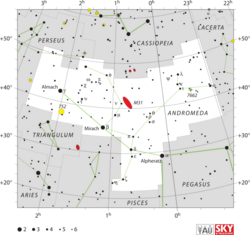Astronomy:Psi Andromedae
| Observation data Equinox J2000.0]] (ICRS) | |
|---|---|
| Constellation | Andromeda |
| Right ascension | 23h 46m 02.04703s[1] |
| Declination | +46° 25′ 12.9865″[1] |
| Apparent magnitude (V) | 4.95[2] |
| Characteristics | |
| Spectral type | K0Ia[3] + B9[4] |
| U−B color index | +0.83[2] |
| B−V color index | +1.085[3] |
| Astrometry | |
| Radial velocity (Rv) | -23.62[3] km/s |
| Proper motion (μ) | RA: 8.446(132)[1] mas/yr Dec.: −7.143(109)[1] mas/yr |
| Parallax (π) | 1.6352 ± 0.1627[1] mas |
| Distance | 2,000 ± 200 ly (610 ± 60 pc) |
| Absolute magnitude (MV) | –3.039[3] |
| Details | |
| ψ And A | |
| Mass | 25[4][3][5] M☉ |
| Radius | 686[5] R☉ |
| Luminosity | 263,000 [5] L☉ |
| Surface gravity (log g) | 1.50[3] cgs |
| Temperature | 4,990[3] K |
| Metallicity [Fe/H] | +0.10[3] dex |
| Age | 79[4] Myr |
| Other designations | |
| Database references | |
| SIMBAD | data |
Psi Andromedae (ψ And, ψ Andromedae) is the Bayer designation for a triple star[4] system in the northern constellation of Andromeda. The combined apparent visual magnitude of this system is 4.95.[2] Based upon parallax measurements, is roughly 2,000 light-years (610 parsecs) from Earth, with a large margin of error.[1]
The primary component has a stellar classification of G5 Ib,[3] which matches the spectrum of an evolved supergiant star. It forms a pair with a star of type B9 with an unknown luminosity class separated by 0.28 arcseconds. A third component has a separation of 0.14 arcseconds. Details of the orbital arrangement remain uncertain.[4]
Psi Andromedae's mass was 25 times massive as the sun, It's luminosity was about 260,000 times of the sun, Psi Andromedae's size was 686 times large as the sun, hence this, If Psi Andromedae was placed into center of the solar system, that It's will engulf Mercury, Venus, Earth, Mars, and even Ceres
Naming
In Chinese, 螣蛇 (Téng Shé), meaning Flying Serpent, refers to an asterism consisting of ψ Andromedae, α Lacertae, 4 Lacertae, π2 Cygni, π1 Cygni, HD 206267, ε Cephei, β Lacertae, σ Cassiopeiae, ρ Cassiopeiae, τ Cassiopeiae, AR Cassiopeiae, 9 Lacertae, 3 Andromedae, 7 Andromedae, 8 Andromedae, λ Andromedae, κ Andromedae and ι Andromedae,. Consequently, the Chinese name for ψ Andromedae itself is 螣蛇二十 (Téng Shé èrshí, English: the Twentieth of Flying Serpent).[7]
References
- ↑ 1.0 1.1 1.2 1.3 1.4 1.5 Brown, A. G. A. (2021). "Gaia Early Data Release 3: Summary of the contents and survey properties". Astronomy & Astrophysics 649: A1. doi:10.1051/0004-6361/202039657. Bibcode: 2021A&A...649A...1G. Gaia EDR3 record for this source at VizieR.
- ↑ 2.0 2.1 2.2 Argue, A. N. (1966), "UBV photometry of 550 F, G and K type stars", Monthly Notices of the Royal Astronomical Society 133 (4): 475–493, doi:10.1093/mnras/133.4.475, Bibcode: 1966MNRAS.133..475A.
- ↑ 3.0 3.1 3.2 3.3 3.4 3.5 3.6 3.7 3.8 Soubiran, C. et al. (March 2008), "Vertical distribution of Galactic disk stars. IV. AMR and AVR from clump giants", Astronomy and Astrophysics 480 (1): 91–101, doi:10.1051/0004-6361:20078788, Bibcode: 2008A&A...480...91S.
- ↑ 4.0 4.1 4.2 4.3 4.4 Parsons, Sidney B. (May 2004), "New and Confirmed Triple Systems with Luminous Cool Primaries and Hot Companions", The Astronomical Journal 127 (5): 2915–2930, doi:10.1086/383546, Bibcode: 2004AJ....127.2915P.
- ↑ 5.0 5.1 5.2 Stassun K.G. (October 2019). "The revised TESS Input Catalog and Candidate Target List". The Astronomical Journal 158 (4): 138. doi:10.3847/1538-3881/ab3467. Bibcode: 2019AJ....158..138S.
- ↑ "* psi And". SIMBAD. Centre de données astronomiques de Strasbourg. http://simbad.u-strasbg.fr/simbad/sim-basic?Ident=%2A+psi+And.
- ↑ (in Chinese) AEEA (Activities of Exhibition and Education in Astronomy) 天文教育資訊網 2006 年 7 月 7 日
 |


